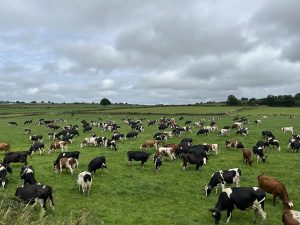
Agricultural emissions are decreasing, while demand for Irish dairy products remains strong.
Dairy is Ireland’s national treasure. It’s been part of Irish life and culture for over 6,000 years. Today, dairy farming and processing sustains 17,500 family-run dairy farms, supporting 54,000 Irish jobs (2.1pc of national employment).
Of course, this isn’t the whole story. Irish agriculture, including Irish dairy, accounts for around 37pc of the country’s greenhouse gas emissions. The government has tasked the sector with reducing those emissions – predominantly methane from animals (CH4) and nitrous oxide (N2O) from fertiliser – by 25pc by 2030.
In 2022, according to the Environmental Protection Agency, agriculture’s emissions decreased, which is good news. But there’s still a way to go. In addition, there’s an increasing focus on improving water quality and biodiversity, both of which will require continued commitment and adaptability from farmers up and down the country.
All that being said, Irish milk, on a litre-for-litre basis, already has one of the lowest carbon footprints of any milk produced anywhere. Dairy products are important as part of a healthy, balanced diet, and the Irish government’s Department of Health recommends 3-5 servings of dairy daily – depending on your age.
But we don’t consume all we produce domestically. Ireland exports dairy to over 130 countries, delivering €6.8bn euro to our economy yearly.
Internationally, the demand for high-quality dairy products is strong. A report from the Department of Agriculture, Food and the Marine in 2022 cited the Organisation for Economic Co-Operation and Development (OECD) and the Food and Agriculture Organisation of the UN (FAO), whose projections estimate relatively sustained global demand for EU dairy produce at least until 2031.
One way of minimising the climate impact of meeting the world’s demand for dairy is to produce as much of it as possible here, in a country with one of the lowest milk carbon footprints (at 0.97kg CO2 eq per litre) of any milk produced anywhere.
Curtailing production here would move it to somewhere else at a higher carbon cost per litre – this is known as ‘carbon leakage’ (the increase in emissions in one country driven by the decrease in emissions of another country divided by that decrease in emissions).
Tom Power, a National Dairy Council Farmer Ambassador farming in Ballymullala, Co. Waterford, wants people to know more about how Irish dairy is focused on its sustainability – social, economic and environmental.
“As farmers, we are committed to reducing our environmental impact, and as a community, we are adopting new technologies and farming practices to meet the challenge we’ve been set.
“We’re also well aware of the economic contribution that dairy makes – in terms of export revenues, jobs and ancillary economic benefits – and also of the history of Irish dairy and its place in our society and our culture.
“Simply put, Irish farmers want to be given the chance to continue to produce some of the best milk in the world while ensuring a future for us, our families and for Irish dairy.”
For more information, click here.

























